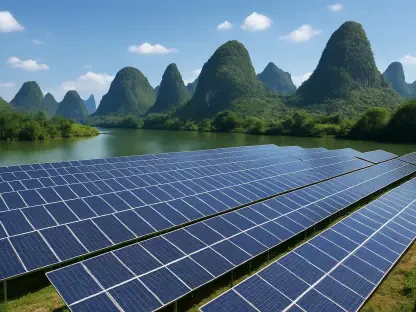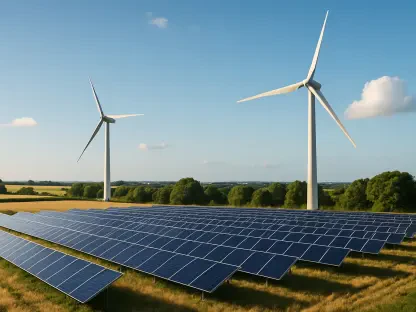As the world faces mounting environmental concerns and energy demands, renewable technologies have taken center stage in the quest for sustainable solutions. Among these technologies, home wind turbines are heralding a new era of opportunity for households aiming to reduce their reliance on conventional power systems. The LIAM F1 turbine from the Netherlands has emerged as a notable innovation in this arena, claiming impressive efficiency and seamless integration with residential environments. This article investigates the turbine’s approach to energy independence and how it fits into broader advancements in sustainable energy.
Integrating Wind Technology within Residential Energy Systems
Revolutionary Design and Functionality
The LIAM F1 turbine is gaining recognition due to its strategic design, combining ancient principles with modern technology. Inspired by Archimedes’ screw, this turbine boasts a unique spiral form that maximizes its ability to harness energy from even the lightest breezes. With a diameter under five feet and weighing approximately 220 pounds, it conveniently fits atop most homes without being invasive or unsightly. The turbine is designed to generate around 1,500 kWh of electricity annually when faced with constant wind speeds of about 11 miles per hour. This output is substantial, covering nearly half of the energy needs of an average household.
Furthermore, the turbine operates silently, eliminating noise pollution concerns that often accompany larger industrial wind turbines. Its compact size and quiet operation have made it a popular choice for suburban areas where roof space is available, allowing residents to contribute to sustainable energy goals without sacrificing the comforts of their living environment. This accessibility demonstrates that energy independence isn’t reserved solely for those with extensive property.
Creating Synergy with Solar Panels
The potential of the LIAM F1 turbine is significantly enhanced when combined with solar panels, illustrating the effectiveness of an integrated renewable energy system. While solar energy generation depends heavily on sunshine availability, wind turbines can function more consistently irrespective of time and weather, providing a stable energy source even during overcast days or at night. This pairing is particularly advantageous during power outages, as the dual system ensures energy supply continuity.
Further benefiting from modern energy storage solutions, like advanced battery systems, homeowners can effectively balance energy production and consumption, storing excess power generated for later use. This not only extends the home’s energy autonomy but also optimizes cost savings by reducing dependency on traditional power grids. As a result, the household’s overall carbon footprint can be significantly minimized, aligning individual efforts with global environmental goals.
Shaping Energy Transformation in the Global Context
Europe Leading by Example
The introduction of the LIAM F1 turbine is a microcosm of Europe’s commitment to energy innovation and sustainability. The European Union has been at the forefront of advocating decentralized energy systems and mandating comprehensive policies that reduce greenhouse gas emissions. Member states are keenly adopting smaller, less intrusive turbines that generate power efficiently while aligning with urban and suburban living. This decentralization movement echoes the broader societal push toward environmental stewardship.
Moreover, policies and incentives supporting renewable adoption have been instrumental in shaping a competitive market for energy solutions like the LIAM F1 turbine. By encouraging innovation and supporting local manufacturing, Europe is fostering a marketplace where individuals have broader access to clean technology options. This ongoing transition away from a centralized, pollution-heavy energy model paves the way for greater individual participation in environmental conservation.
Pioneering a New Mindset
This transformative shift highlights the growing trend of individuals seeking energy independence not only as a means to reduce costs but as a personal contribution to global ecological well-being. Homeowners gaining more control over their energy consumption inherently promote sustainability as part of their daily lives. The LIAM F1 turbine is not merely a product but a catalyst for a broader change in how society views and utilizes energy resources.
Moreover, the normalization of user-friendly, small-scale energy systems empowers communities to engage actively in the sustainability discussion. The adaptability and efficiency of the LIAM F1 turbine prompt a change in mindset toward recognizing renewable energy solutions as viable and necessary. Encouraging broader adoption and promoting dialogue around innovative home energy solutions will be vital for ensuring future advancements in technology align with the growing demand for clean energy.
A Vision for Sustainable Living
As the world grapples with growing environmental concerns and the need for sustainable energy solutions, renewable technologies are playing a central role. Home wind turbines, in particular, are providing an exciting opportunity for households seeking to decrease their dependency on traditional power sources. One noteworthy development in this field is the LIAM F1 turbine, originating from the Netherlands. This turbine is lauded for its remarkable efficiency and its ability to blend effortlessly into residential settings. Its design offers a glimpse into the future of energy independence for homeowners. With the increased emphasis on sustainable practices, integrating such technologies within homes not only supports environmental goals but also promotes energy self-reliance. As technological advancements continue to evolve, systems like the LIAM F1 are poised to significantly contribute to the broader movement toward more sustainable energy practices, reshaping how households manage their energy consumption and align with global environmental objectives.









